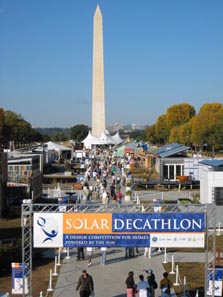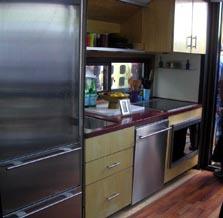
Click photo to view a larger image.


Roof-mounted evacuated tube collectors were a key part of the Kansas team's hot water system.

Some of Texas A&M's appliances are nicely grouped in their compact and well-designed kitchen.
Solar Decathlon 2007
Daily Journal - October 20, 2007
Last Day for Public Tours
Today is a huge day for public tours in the village. The houses are open from 10 a.m. to 5 p.m. on this, the last day the complete village will exist for another two years. Even though the competition for overall winner has ended, the teams are still excited to share their story and the story of solar power with everyone who comes here from around the world.
For the last several days, our journal has reported on the winners of several of the Solar Decathlon's ten contests. These were awards scored by teams of jurors who are experts in the appropriate fields for the architecture, engineering, communications, lighting, and market viability contests. But there are five other contests that are also critical to success in the Solar Decathlon and these are scored by actually measuring performance, such as meeting certain temperature requirements.
There are no jury judgments in these contests; they are "hard-wired" (or frequently wireless, these days) measurements in the comfort zone, appliances, hot water, energy balance, and getting around contests. Each of these contests is worth a total of 100 points and while placing in any of them is an honor in itself, these scores have a significant impact on determining the Solar Decathlon's overall winner.
The awards for these performance measurement contests couldn't be presented without the talented and very hard-working Instrumentation Team, with whom the decathletes become very well acquainted during the competition. This team consists of Ed Hancock, Greg Barker, Norm Weaver, Paul Norton, Charles Newcombe, Greg Shoukas, and Sara Farrar-Nagy.
Let's look briefly at the placements in each of these performance contests.
Comfort Zone Contest—The Solar Decathlon teams design their houses to maintain a steady, uniform, comfortable temperature and humidity throughout. Placements for this contest are as follows:
1st Place, University of Illinois, 81.343 points
2nd Place, Team Montréal (École de Technologie Supérieure, Université de Montréal, McGill University), 77.852 points
3rd Place, University of Texas at Austin, 75.716 points
Appliances Contest—The houses are required to reproduce appliance energy use in the average U.S. home, which includes maintaining prescribed temperature ranges in their refrigerators and freezers, washing and drying towels, cooking and serving meals, running a dishwasher, and operating a TV/video player and a computer. Placements for this contest are as follows:
1st Place, Texas A&M University, 98.191 points
2nd Place, Santa Clara University, 93.767 points
3rd Place, Technische Universität Darmstadt, 89.206 points
Hot Water Contest—This contest demonstrates that solar hot water systems can supply all the hot water that households use daily for bathing, laundry, and dishwashing. There were several teams that achieved a perfect score of 100 points in this challenging contest, including Santa Clara University, Penn State, Universidad de Puerto Rico, the Kansas Project (Kansas State University and University of Kansas), and University of Texas at Austin.
Energy Balance Contest—Teams are required to use only the energy generated by the solar electric systems (also called photovoltaic or "PV" systems) on their houses during the competition. Seven teams achieved a perfect score of 100 points in this critical contest by the energy supplied to the batteries being at least as much as the energy removed from the batteries during the competition. These teams are Technische Universität Darmstadt, University of Maryland, Santa Clara University, Universidad Politécnica de Madrid, Massachusetts Institute of Technology, Carnegie Mellon University, and University of Cincinnati.
Getting Around Contest—Powering a street-legal, commercially-available electric vehicle with the house's solar electric system is also a factor in the competition. Points are awarded based on how many miles each team completes and the placements for this contest are as follows:
1st Place, University of Colorado, 86.335 points
2nd Place, Santa Clara University, 84.946 points
3rd Place, Georgia Institute of Technology, 84.010 points
All of these teams are great competitors and we honor their achievements in these contests.
